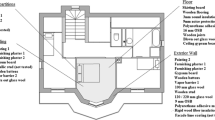Abstract
A comprehensive modelling study was performed to determine volatile organic compounds (VOCs) emission factors in dry building materials. In order to examine the emission characteristics of VOCs in dry building materials (carpet), an experiment was conducted, and a mathematical methodology was considered together with a numerical work for a validation. Here, a new representative airside VOCs concentration was considered in a mode different from that of previous studies, which allows us to evaluate VOCs emission factors more accurately.








Similar content being viewed by others
Abbreviations
- A :
-
Source area (m2)
- C :
-
Concentration (μg m−3)
- D :
-
Diffusion coefficient (m2 s−1)
- K :
-
Partition coefficient (–)
- L :
-
Product loading (m2 m−3)
- l :
-
Carpet thickness (m)
- N :
-
Air exchange rate (h−1)
- M>E :
-
Total mass emitted from the source during experimental period (μg)
- M>a,F :
-
Total mass in the chamber air at the end of experimental (μg)
- M>a,B :
-
Total mass in the chamber air at the beginning of the experimental (μg)
- M>s,F :
-
Total mass absorbed by the chamber walls at the end of experimental (μg)
- M>s,B :
-
Total mass absorbed by the chamber walls at the beginning of experimental (μg)
- M>x :
-
Total mass leaving the chamber with the air change flow (μg)
- P :
-
Pressure (Pa)
- Q :
-
Volumetric air flow rate through chamber (m3 s−1)
- t :
-
Time (s)
- V :
-
Volume of air in chamber (m3)
- x>i :
-
Direction tensor (m)
- 0:
-
Initial
- A :
-
Air phase
- C :
-
Carpet phase
- i :
-
ith time step
- ρ :
-
Density (kg m−3)
- μ :
-
Viscosity (kg m−1 s−1)
References
Sack TM, Steele DO, Hammerstrom K, Remmers J (1992) A survey of household products for volatile organic compounds. Atmos Environ 26A:1063–1070
Vanderwal JF, Hoogeveen AW, Wouda P (1997) The influence of temperature on the emission of volatile organic compounds from PVC flooring, carpet, and paint. Indoor Air 7:215–221
Hodgson AT, Wooley JD, Daisey JM (1993) Emissions of volatile organic compounds from new carpets measured in a large-scale environmental chamber. J Air Waste 43:316–324
Wolkoff P (1998) Impact of air velocity, temperature, humidity, and air on long-term voc emissions from building products. Atmos Environ 32:2659–2668
Knudsen HN, Kjaer UD, Nielsen PA, Wolkoff P (1999) Sensory and chemical characterization of VOC emissions from building products: impact of concentration and air velocity. Atmos Environ 33:1217–1230
Dunn JE (1987) Models and statistical methods for gaseous emission testing of finite sources in well-mixed chambers. Atmos Environ 21:425–430
Little JC, Hodgson AT, Gadgil AT (1994) Modeling emissions of volatile organic compounds from new carpets. Atmos Environ 28:227–234
Huang H, Haghighat F (2002) Modelling of volatile organic compounds emission from dry building materials. Build Environ 37:1349–1360
Cox SS, Little JC, Hodgson AT (2002) Predicting the emission rate of volatile organic compounds from vinyl flooring. Environ Sci Technol 36:709–714
Cheng TY, Jiang Y, Xu Y, Zuang Y (2002) Mathematical model for simulation of VOC emissions and concentrations in buildings. Atmos Environ 36:5025–5030
Yang X, Chen Q, Bluyseen PM (1998) Prediction of short-term and long-term VOC emission from SBR Bitumen-backed carpet under different temperatures. ASHRAE Trans 104:1297–1308
Shin DM, Kim CN, Kim DS (2003) Emission characteristics of volatile organic compounds (VOCs) from a carpet. Korean J SAREK 15:40–49
ASTM D5116-06 (2006) American Society for Testing and Materials (ASTM)
US EPC TO-17 (1999) Center for Environmental Research Information Office of Research and Development United State Environmental Protection Agency, 2nd edn. Cincinnati
Press WH, Teukolsky SA, Vettering WT, Flannery BP (1992) Numerical recipes in FORTRAN: the art of scientific computing, 2nd edn. Cambridge University Press, Cambridge
Bodalal A, Zhang JS, Plett EG (2000) A method for measuring internal diffusion and equilibrium partition coefficients of volatile organic compounds for building materials. Build Environ 35:101–110
Clark MM (1996) Transport modeling for environmental engineers and scientists. Wiley, New York
Spaks LE, Tickenor BA, Chang J, Guo Z (1996) Gas-Phase mass transfer model for predicting volatile organic compound (VOC) emission rates from indoor pollutant sources. Indoor Air 6:31–40
Lide DR (2000) CRC handbook of chemistry and physics, 3rd edn. CRC Press, Boca Raton
Rafson HJ (1998) Odor and VOC control handbook. McGraw-Hill, New York
Author information
Authors and Affiliations
Corresponding author
Rights and permissions
About this article
Cite this article
Shin, D.M., Kim, C.N., Park, CH. et al. On the determination of VOCs emission factors in dry building materials. Heat Mass Transfer 49, 1625–1635 (2013). https://doi.org/10.1007/s00231-013-1201-4
Received:
Accepted:
Published:
Issue Date:
DOI: https://doi.org/10.1007/s00231-013-1201-4




